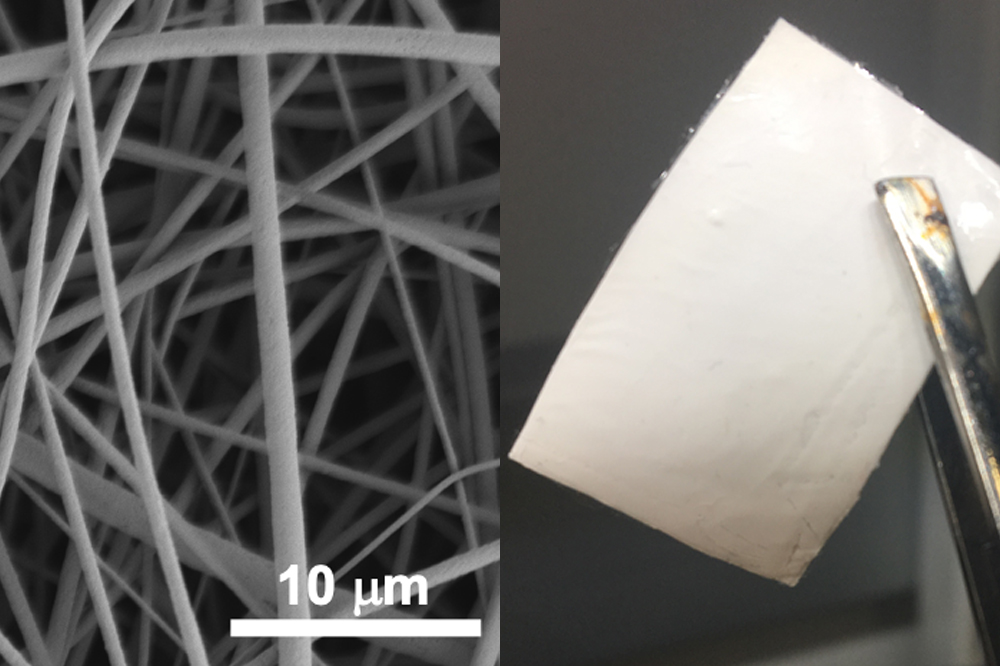By Ruth Steinhardt
A researcher at the George Washington University is developing nanofiber fabrics for masks and air filters that might not only filter out the COVID-19 virus more effectively, but also could prevent its environmental transmission.
Danmeng Shuai, an associate professor of civil and environmental engineering in the School of Engineering and Applied Science, works in electrospinning, a manufacturing technique for generating ultrafine fibers. A polymer solution is ejected from a needle under a high voltage, and the solution droplets polarize and repel each other to form threads as thin as 100 nanometers. The technique forms a microscopically fine mesh with pores so minute that they exclude almost all pathogens and allergens.
“Think about it like the mesh screen on a window, except that these fibers are so small that you cannot see the grid,” Dr. Shuai said.
Dr. Shuai and his collaborator Yun Shen, an assistant research professor of occupational and environmental health in the Milken Institute School of Public Health who is also his wife, recently received a $200,000 yearlong Rapid Response Research grant (RAPID) from the National Science Foundation to develop ways in which electrospun nanofibers could be used to filter airborne COVID-19 in personal protective equipment and industrial or residential HVAC systems.
“Our lab has already synthesized a broad range of electrospun nanofibers made from different polymers, but we haven’t yet tested their performance specifically for coronavirus capture, so that is our first goal,” Dr. Shuai said.
But Dr. Shuai and his team also want to go beyond conventional electrospinning techniques and objectives to combat COVID-19 even more effectively.
“Before, we’ve mainly focused on fiber diameter and porosity, and those things are critical to remove pathogens in water or air,” Dr. Shuai said. “But now we want to allow more functions for these air filters.”
One possibility is to manufacture organic polymer “branches” atop the nanofibers, simulating microscopic virus receptors in the human body. (Coronaviruses cause infection by attaching to these receptors on target cells.) Like locks fitting keys, these branched nanofibers could capture COVID-19 viruses more effectively than a simple filter would, preventing them from detaching.
“I know it sounds a little crazy, but it’s just a simulation of what goes on in the biological system,” Dr. Shuai said.
The team is also investigating ways to safely increase the surface charge of the nanofibers, causing higher electrostatic attraction and therefore tighter binding between it and the naturally charged coronavirus particles. Like the artificial receptors, this increased binding would reduce the possibility of transferring the virus from the filter back into the air.
“We use high voltage to synthesize these nanofibers, so in principle they should have a surface charge and presumably that’s a property we could play with,” Dr. Shuai said. “But is it dependent on the fiber size, the pore size or the different type of polymers we use? These are things we don’t know at the moment.”
The technology is particularly exciting to Dr. Shuai because, like 3-D printers, handheld electrospinning devices exist. They are generally used in hospitals to create nanospun dressings for wound care. But if Dr. Shuai’s technique does produce especially effective PPE, a hospital, small community or even a single house could eventually use such devices to manufacture their own masks and other materials—combatting national shortages.
“This could really expand public access to this type of mask when needed,” he said.
Dr. Shuai also looks forward to the possibility of working with other researchers across GW.
“I know GW has researchers working with our 3-D printers to print respirators, and I think our technology can complement their technology,” Dr. Shuai said. “They are fabricating a scaffold, and we are fabricating the filtration media that goes over that scaffold. Our two technologies together can create complete respirators.”



